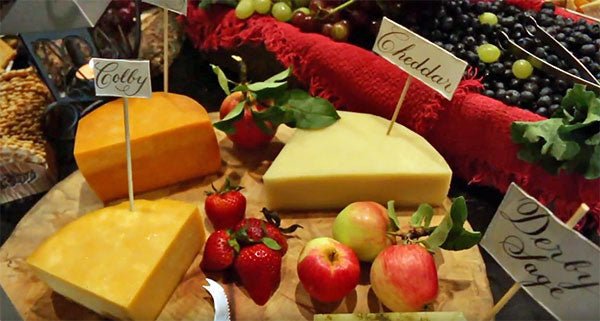
Anne Larsen first wrote to us with a comment at one of our blog articles about making yogurt in the Instant Pot (click here). She was using the pot to make her soft cheeses as well:
The Instant Pot’s yogurt cycle makes superb fromagina, fromage blanc, and chevre. It can handle two quarts of milk at a time, which none of my other methods can easily do.
I start with a half gallon of raw goat milk, add 12 drops of calcium chloride (I have found this gives a firmer set), and start the yogurt cycle. This pasteurizes the milk for me in addition to prepping those little proteins.
After the first phase is done, I take the stainless pot out and let the milk cool on a wire rack to the appropriate temperature for innoculation. Then, it goes back into the pot and I run the second phase of the yogurt cycle.
This morning I got the nicest, firmest set on fromage blanc I’ve ever had – it was my first time trying this culture this way. It drained almost immediately because the curd was so firm. The fromagina has come out beautifully twice. I think the slightly higher-than-room-temp fermentation keeps with wee bugs happier.
Anne also, graciously, shared her method for making butter which you will find at the end of this interview.

Anne with her gelding, Fox, whom she no longer has. She misses him terribly.
How did you get started making cheese?
I have been a curious cook since childhood, but it was the pressure and emotional toll of graduate school that made my kitchen a place of sanctuary. I read Harold McGee’s On Food and Cooking: the Science and Lore of the Kitchen and all my earlier questions spawned even more. First I made ice cream using his recipe, then yogurt, then, when I had a better kitchen, I bought Ricki’s book, Home Cheese Making (in 1989). I had a friend with dairy cattle who would let me come get raw milk. I made Neufchatel, cottage cheese, and creme fraiche. Cutting firm curd is uniquely satisfying. I did not have a cheese press or a place to age cheeses, so I had to stay in the Fresh Cheese Zoo.
I moved to WV and discovered I had an unusual degree of control over my food supply. A kitchen garden, fruit cage, the farmer’s market, and friends with happy hens and thriving livestock shifted me into a new culinary stage in my life. Being able to get superb grassfed milk that has not been destroyed by ultra-pasteurization meant that cheese making was far more satisfying. I had been so frustrated by the failures caused by industrially de-natured proteins that I’d drifted away from my beloved lactobacilli buddies.

Anne’s garden, early in 2016.

A raised bed that she built for her mom so she could garden without having to bend over or be on her knees. For many years it gave her lettuce, kale, bush beans, cukes, and radishes.

Her garden, later in 2016. “My tomatoes look like a rugby scrum lurking behind the rhubarb and herb bed. That was a banner year for them.”

I also bought a bottle of calcium chloride from NES and that made a tremendous difference as well, particularly in getting a firm set in goat milk. One day I will have my cheese press and my cheese cave, and you can bet I’ll be generating splendid cylinders of aged cheese. But for now, fresh cheeses and yogurt are staples in my diet, and I feel so blessed to know where my milk came from, how its been treated on its way to me, and what happens to it during the fermentation process. Only milk and microbes, no gels and goos and other unwelcome additives.
Are you using goat milk exclusively?
I use goat milk only when it’s available through my friends’ farm. They have a dairy certified for aged cheeses, and soon will have a pasteurizer so they can do fresh cheeses. I took Suzanne a batch of goat fromagina seasoned with fresh rosemary, ground lavender, ground black pepper and sea salt. She and her daughter, the Goat Manager, agree that it will be a terrific signature cheese for their farm, which is what I’d hoped. I will mix up the dry ingredients in the right proportions, and they can add the rosemary fresh. As I am helping develop a business plan for an organic lavender farm in CA, I have been doing lots of culinary experiments with dried lavender buds, and this cheese was one of the keepers.
Before I had access to this goat milk source (i.e. up until this past spring), I made chevre only when I could afford a half gallon of goat milk from Trickling Springs – and it was a special order item for my local retail place. Otherwise I used cow milk, either from Trickling Springs or from a local PA supplier of splendid raw milk. I live only 25 minutes south of the PA border, so it was easy to zip up and fetch my order from the delivery guy. Happily, WV has finally decided that raw milk is okay, so I’m no longer bootlegging my cow juice.

A collaboration: Anne did the reticulated silver bowl and her friend Lynda Smith-Brugge, a wood sculptor, did the base. It’s 11″ long and 4″ high.
Yesterday I was thinking about how I consider my cheesemaking, along with my bread making (especially sourdough) and sauerkraut as gardening. You create the optimal environment for the organisms involved, and reap the product of their healthy lives. It’s an on-going conversation with an ecosystem whose inhabitants have had a very long history cooperating with humans. As Michael Pollen describes in his book Cooked, the relationship made critical nutrients more available for the human gut, and helps to keep our inner ecosystem healthy as well. How can I help but be grateful for such connections?
What do you do for a living?
I am a freelance technical writer/researcher and a substitute teacher (K-12, all subjects) in Morgan County, a rural school district in the eastern panhandle of WV. I haven’t been doing as much work in the studio as I’d like* – I am doing a lot of writing (fiction and technical+research), and a lot of substitute teaching. In the summer, I am usually gardening, though this year’s unrelenting rain means the beds are fallow.
I work for Red Road Media, Inc, a company that develops interactive software and designs interactive displays for museums, universities, hospitals, and so forth. Red Road has design, graphics, and software experts and once they have created a display, I am often asked to write the text that goes into it. I also get small free-lance writing jobs from local businesses who need press releases and marketing materials. Finally, I write long and short fiction and poetry.
* Trained in both silver and goldsmithing, Anne uses precious metals, stones, and enamel to create unusual jewelry, boxes, bowls and flatware.
Anne’s Cultured Butter
Here in eastern WV it is muggy, buggy, and gray, and has been for many days. This is a fallow year for my kitchen garden, and this has left me a bit adrift culinarily and spiritually. However, even on dismal days one can enlist the magic of microbes to do astonishing things to dairy. You need the right dairy, though: Trickling Springs Heavy Cream from grassfed Jerseys, not destroyed by ultra-pasteurization or polluted with additives. A pint will do, a quart is better. (Locals: you can get this at Community Garden Market.) Next, you need a packet of buttermilk culture from the good people at New England Cheese Making (cheesemaking.com).


Follow the simple instructions, heating the cream to 86F and inoculating it. Put a lid on the jar and put it somewhere it will stay warm, like inside a picnic thermos jug. It doesn’t need to be hot, just between 75-80F or so. Let it sit for 10-12 hours.
It helps to have a mixer for the next step – even a hand mixer will do, as will an egg beater. The cream will have thickened to the consistency of a milkshake and will be fragrant (in a good way). Dump the jar into the mixer bowl and, using the paddle attachment, stir the cream on a low setting. No splashing; you aren’t making whipped cream. It will take about 10 minutes, but suddenly the sound will change from the hum of the mixer to the hum with a distinctive splash as the cream “breaks,” when the butterfat suddenly clumps together and flops about in the buttermilk. Run the mixer a bit longer to be sure you have all the fat drawn out.

Carefully lift the butter into a bowl of ice water with a slotted spoon. Drain the buttermilk into a jar for drinking later – it will be the best buttermilk you’ve ever tasted. You need to rinse the butter in cold water several times to get the last of the milk out of it. The water should run clear. Don’t get in there with your hands and squish it, because it’s very soft and your hands are too warm.
When it’s done, put the butter in a bowl of cold water and tuck it in the fridge to harden a bit. When it’s firmer, you can pack it into a lovely container, preferably with a lid. Squeeze out as much water as you can while packing it together. You can salt it if you want at this point, but I prefer mine sweet. Make toast. Bake a potato. Consume within a week (if you can restrain yourself that long, I’m impressed), or freeze half of it while you’re eating the other half. Sip chilled buttermilk on the veranda in the evening as the fireflies rise. Rejoice that there are such microbes in the world whose magic we can enjoy.















































































































































